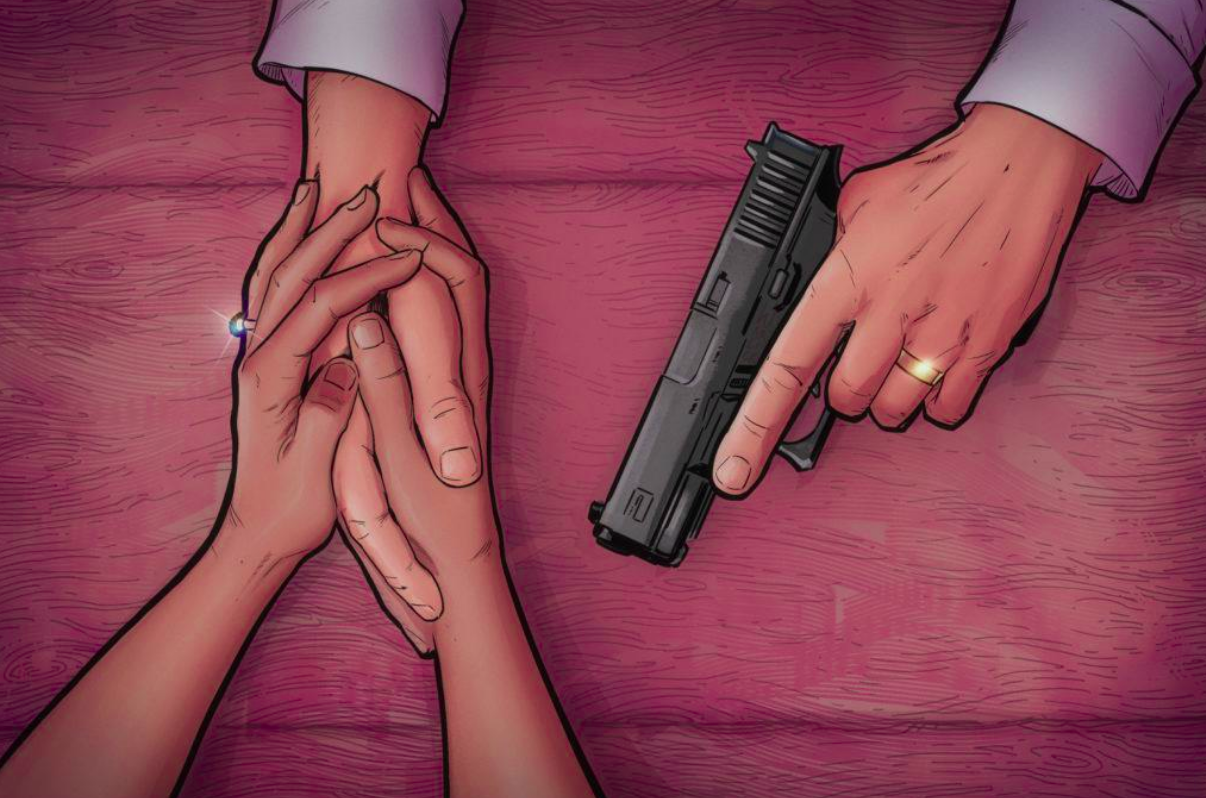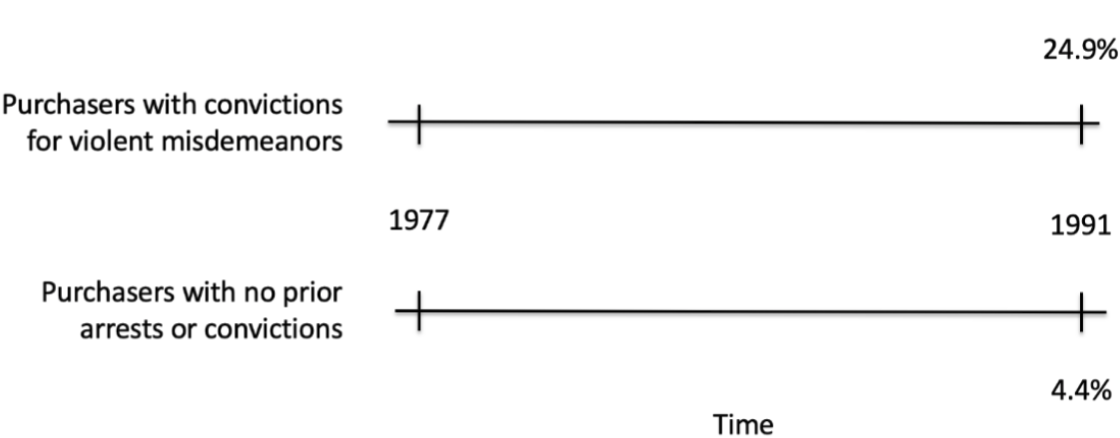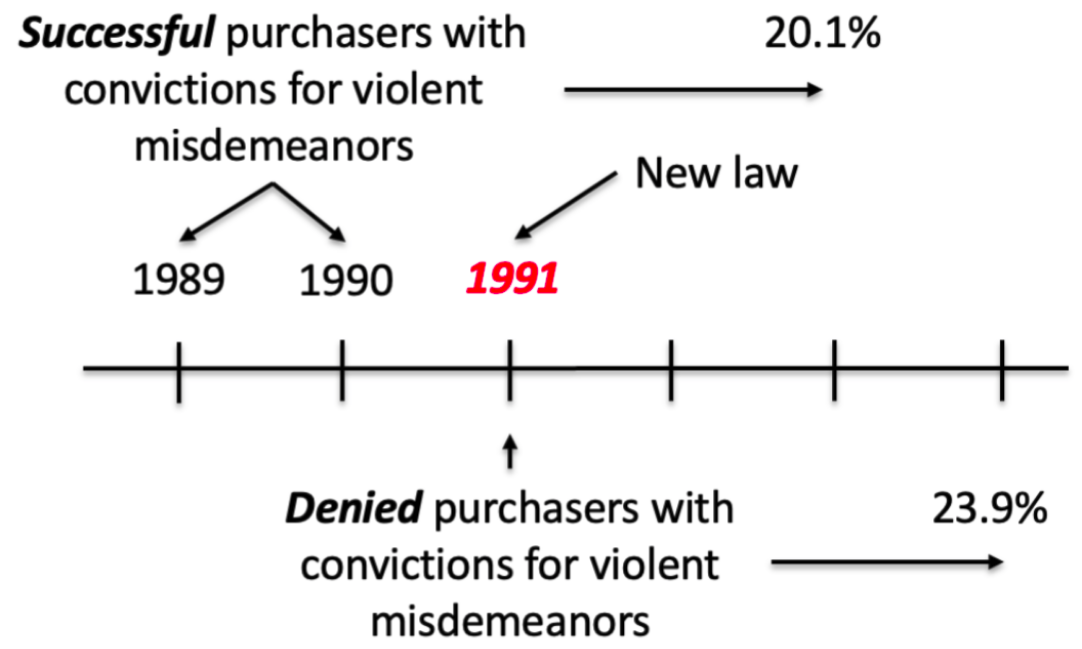This is the sixth post in a series about Reducing Gun Violence in the United States. The previous post described Age-Related Firearm Restrictions and Safe Storage Laws.
In this post, I’ll explore gun violence as it relates to intimate partners, violent misdemeanors, alcohol and drug usage.
- For those who want to see the highlights without going through the data, skip right to the conclusions at the bottom of this post.
- The data in this post comes from several different sources, which I’ve linked in the references section at the bottom of this post for those who want to see the data for themselves or dive deeper.
Gun Violence, Intimate Partner Violence, and Gun Policy

Firearms are used as a way to intimate and control others as well as harm them physically. In domestic violence situations, they’re often used to pressure a partner into some behavior (or to prevent some behavior), and they’re incredibly effective at doing so. In intimate partner homicides, firearms were used in over 50% of cases.
- When a violence domestic partner has access to a firearm, the risk of intimate partner homicide increases by 400%.
One might ask the question: if we remove the firearm from a partner who might be violent, would that solve the problem?
Federal law allows for something called a domestic violence restraining order, which allows a judge to order the removal of a gun from a person at risk for harming their partner. However, these restraining orders come with some severe restrictions:
- the partners must be married or must have been married at one point or must be living together currently or have a child together (collectively known as the Boyfriend Loophole)
- a hearing must be held before a judge, including both the offender and the victim, before an order can be signed
Imagine dating a violently abusive partner who you don’t live with – you can’t use federal law to get a gun violence restraining order. Similarly, you cannot petition the court on your own – your violent partner must also show up in court with you. One can clearly see how weak federal law is in protecting domestic violence victims given these limitations.
A variety of temporary or emergency restrictions exist at the state level, which can remove firearms from a domestic abuser for a temporary period of time (such as 21 days in California) without a full court hearing, though they are inconsistent and sometimes hinge on having past criminal convictions for domestic violence. Only about 51% of severe domestic violence events are reported to the police anyway, with even fewer guilty convictions, which severely restricts the effectiveness of many of these state laws. So, the laws which protect those at risk for domestic violence leave much to be desired.
Nonetheless, there is research on the effectiveness of state laws for domestic violence gun restrictions, and it shows significant impacts (source: Legal Firearms Restrictions):
- domestic violence restraining orders (either at the state or local level) restricting firearm possession and purchase reduce the rates of intimate partner homicide by about 10%
- state laws restricting firearm possession and purchase due to previous violent misdemeanor convictions also reduce intimate partner homicide by about 23% (regardless of the relationship between partner and victim)
- total intimate partner homicides (not just firearm-related) also go down with the implementation of these policies
- so the reduction in firearm homicides is not “made up” by other kinds of homicides
- when states include dating partners in these laws (not just legal spouses), there is an additional 13% reduction in risk of intimate partner homicide
In many cases, state laws that restrict firearm possession due to a restraining order like the ones above prohibit gun possession, but there is often no enforcement effect – no police officers arrive to collect those guns in many cases. As a result, the policies have a limited effect. However, in states where the laws order that the offender surrender their weapon to law enforcement officers promptly, there is a further 12% reduction in intimate partner homicide.
Violent Misdemeanors, Alcohol, and Drugs
Can we identify individuals who are at high-risk for committing firearm violence in order to take proactive steps to reduce that risk? It turns out that we can.
Does past violent behavior predict future violent behavior? (source: Prior Misdemeanor Convictions)
 A study followed handgun purchasers who had previous violent misdemeanor convictions and those which had none; the study controlled for factors that could influence the arrest rate, such as age, gender, and race. After 13 years, those individuals who had previous violent misdemeanor convictions who purchased firearms were over five times more likely to be arrested for another violent offense vs those without previous convictions (4.4% for purchasers without prior convictions vs 24.9% for those with prior convictions). In fact, those individuals with higher numbers of prior convictions had even higher rates of future violent act arrests.
A study followed handgun purchasers who had previous violent misdemeanor convictions and those which had none; the study controlled for factors that could influence the arrest rate, such as age, gender, and race. After 13 years, those individuals who had previous violent misdemeanor convictions who purchased firearms were over five times more likely to be arrested for another violent offense vs those without previous convictions (4.4% for purchasers without prior convictions vs 24.9% for those with prior convictions). In fact, those individuals with higher numbers of prior convictions had even higher rates of future violent act arrests.
Alcohol is also a factor in predicting violent behavior with firearms. Firearm owners are more likely to admit to heavy alcohol use than non-firearm owners, and, among firearm homicide offenders: (source: Alcohol-Involved Homicide)
- an estimated 48% of those offenders were under the influence of alcohol during their offense
Do previous alcohol-related convictions predict violent behavior? (source: Firearms, Alcohol, and Crime)
Another study, similar to the one above, looked at future violent offender rates for those with previous alcohol-related crimes (such as driving while intoxicated or drunk and disorderly behavior) vs those without. Again, after 13 years, those individuals who had previous alcohol-related convictions who purchased firearms were over five times more likely to be arrested for a violent offense (5.7% for purchasers without prior convictions vs 32.8% for those with prior convictions).
The correlation between illegal drug use and violent behavior is less clear. There appears to be some correlation between illegal drug use and increased rates of violent behavior, but it varies per drug type, and so it’s unclear if the predictive effect is due to other behaviors (such as drug dealing or related alcohol use) (source: Controlled Substances and Violence).
How effective are laws that restrict firearm purchasing for individuals with past violent misdemeanor convictions? (source: Subsequent Criminal Activity)

One study from the implementation of a California law in 1991 restricting purchase or possession of firearms for individuals with prior violent misdemeanor convictions showed that
- those individuals with such criminal records who were allowed to purchase or possess firearms were 3% more likely to be arrested for violent or firearm-related crimes than those who were denied purchase or possession
Three states and Washington, D.C. have laws with similar restrictions, but no studies have evaluated their effectiveness. There is also a federal law that bans purchase and possession of firearms for “An unlawful user of or addicted to any controlled substance”, but the effects of that law have also not been studied.
So, there clearly are risk factors for predicting violent behavior, and evidence that firearm purchase and possession restrictions do work, but more rigorous studies are needed.
Conclusions
Gun Violence, Intimate Partner Violence, and Gun Policy
- In intimate partner homicides, firearms were used in over 50% of cases
- When a violence domestic partner has access to a firearm, the risk of intimate partner homicide increases by 400%
- Federal law for domestic violence restraining orders is weak and has severe limitations which reduce its effectiveness
- State laws protecting domestic violence victims are most effective when they:
- cover marital and dating partners
- do not require the offender and victim to show up in court for temporary, emergency gun removals
- implement prompt surrender of guns to law enforcement officers
Violent Misdemeanors, Alcohol, and Drugs
- Clear risk factors exist for predicting violent behavior
- past violent behavior (5x increase in risk)
- past alcohol-related offenses (5x increase in risk)
- some illegal drug use
- Some evidence exists showing that firearm purchase and possession restrictions do work
- More research is needed
Next up: Mental Illness, Violence, and Laws
References
- Legal Firearms Restrictions – a 2018 study looking at the association of intimate partner violence with policy restrictions
- Prior Misdemeanor Convictions – a 1998 study to determine the correlation between prior violent misdemeanor convictions and future violent offense rate
- Alcohol-Involved Homicide – a 2013 meta-study showing the prevalence of alcohol-involved homicide offending
- Firearms, Alcohol, and Crime – a 2017 study on misuse of alcohol and risk for future violence among gun owners
- Controlled Substances and Violence – a 2016 study examining the relationship between illegal drug use and firearm violence
- Subsequent Criminal Activity – a 2001 study exploring the risk factors and effectiveness of denying handgun purchases to those with previous violent misdemeanors
